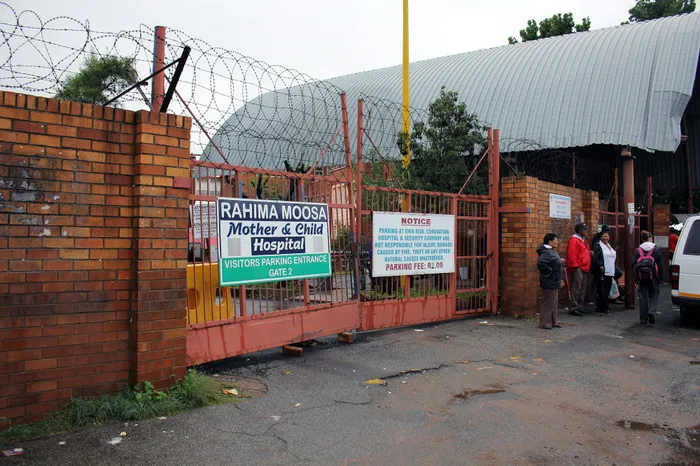SA: Uncaring state shirks duty over quality maternity care

Picture: Wesley Fester/Supplied - Rahima Moosa hospital is among some of the hospitals that have come under the spotlight over providing poor healthcare to patients in Gauteng.
By Vhonani Petla
The state of public health-care in South Africa continues to depreciate daily. Unfortunately, the poor become the most vulnerable and ultimately suffer the most. Complaints of negligence, inadequate resources, long waiting periods and, in some cases, the attitudes of the staff have been among the public’s popular grievances regarding these public health-care facilities. In the first five months of this year, there has been a public outcry in the media over public hospitals’ maternity units and the danger they have put the lives of their patients in.
In Gauteng, two of Johannesburg’s leading public hospitals, Chris Hani Baragwanath Academic Hospital, known as Africa’s biggest hospital, and Rahima Moosa Mother and Child Hospital, South Africa’s only mother and child hospital, which is estimated to deliver about 15 000 babies a year, have been in the spotlight.
Earlier this year, shocking findings from an investigation at Rahima Moosa Mother and Child Hospital were published. The health ombud, Professor Malegapuru Makgoba, noted that during the investigation, the three popular words that came up in the state of the hospital were “unsafe, filthy and dirty.” Furthermore, it was found that the hospital did not have in-house laboratory services, a blood bank and an intensive care unit (ICU). This is concerning not only because a hospital should not be in that state, but also because this hospital services a large number of people, most of whom already come from poor socio-economic conditions and should not be compromised any further, as unfortunately, they do not have alternative options in terms of their health care.
Similarly, findings of an investigation at Chris Hani Baragwanath’s maternity unit have also shown how dire the case of public maternity care is in the country. Health Minister Joe Phaahla wrote to Parliament in a response that there had been 1 824 infant deaths at the hospital between 2020 and 2022. Furthermore, more recent finds have shown that the hospital had 50 medical negligence claims totalling about R1 billion over the past three years. This once again shows that these hospitals that people rely on are the same places that cause harm and distress to their patients. Even more shocking is that in both these hospitals, some of the causes are avoidable.
It is not as though the Department of Health is unaware of the state of these maternity units. The conversations on the state of these units, among other public health services, date back to 2013. This includes the Presidential Health Compact that was signed in 2019. However, despite various efforts, more needs to be done in this regard. Instead, the lives of the poor and users of public health services continue to be compromised in these hospitals. What is sad for most of these women is that they do not have alternative solutions and have to risk their lives at these hospitals.
The prices of private birthing services are also way out of reach for them, with birthing centres charging from about R12 000 to R30 000 for a birth and private hospitals charging a minimum of R20 000, excluding complications or any other emergency that might come up. In a country like South Africa, which is said to be the most unequal country in the world, with 47% of South Africans relying on social grants and a 37.2% unemployment rate, these facilities remain inaccessible to many of these people. Even so, people should not need to consider private health care as their chance of getting quality health-care services; public health-care facilities should be functional and able to provide these at any time.
Furthermore, it is important to consider both infant and maternal mortality rates, which South Africa should be actively fighting against. There is a direct link between the quality of care given at these hospitals and the country’s ability to fight these, as some of the causes include the quality of care at these hospitals. As it stands, the infant mortality rate is currently at 24 deaths per 1 000 live births. This decline is slightly over 2% from the previous year. While others might celebrate the small decline, the truth is that more can be done to ensure that the quality of health-care services given in this country does not cost human beings their lives. Especially those who do not have the option of alternative health care. At this point, quality health-care equates to dignity, and every person deserves to have their dignity preserved.
More than anything, it is the government’s responsibility to ensure that hospitals are safe and reliable and provide adequate services to these women and other people who use them. There should not be conversations about people needing to use alternative private services; it is the responsibility of the government to offer adequate services.
Organisations and universities like Wits have taken their time to conduct various studies and investigations on the state of these units, and all the data is at the disposal of the Department of Health; they need to make use of the data. It is their responsibility to ensure that they prioritise fixing these hospitals. It is unfair that people should continue to be subjected to poor and life-threatening health-care services in this country. As with most issues affecting South Africa, it is time for the government to move from talking and acknowledging that the problem exists, to prioritising fixing the hospitals, preventing further deaths and damages and, most importantly, restoring the dignity of the people who make use of these hospitals.
*Vhonani Petla is a junior researcher at the Digital Africa Research Unit at the University of Johannesburg.